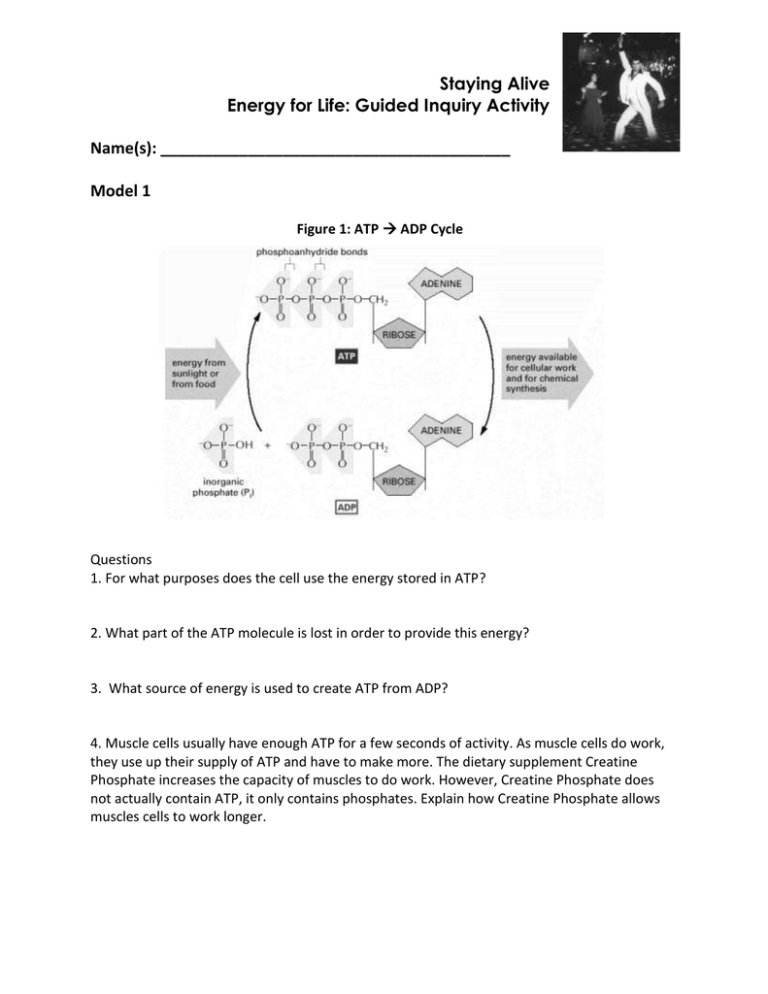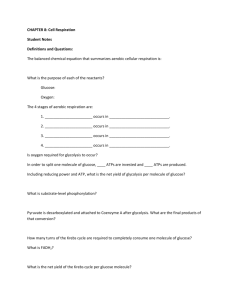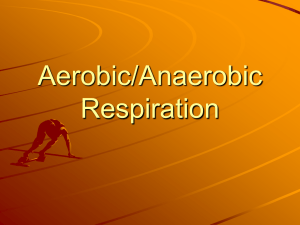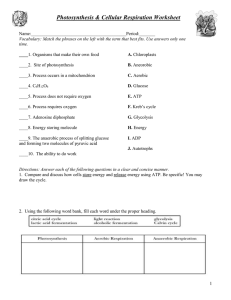Energy for Life: ATP, Respiration, & Fermentation Activity
advertisement

Staying Alive Energy for Life: Guided Inquiry Activity Name(s): ________________________________________ Model 1 Figure 1: ATP ADP Cycle Questions 1. For what purposes does the cell use the energy stored in ATP? 2. What part of the ATP molecule is lost in order to provide this energy? 3. What source of energy is used to create ATP from ADP? 4. Muscle cells usually have enough ATP for a few seconds of activity. As muscle cells do work, they use up their supply of ATP and have to make more. The dietary supplement Creatine Phosphate increases the capacity of muscles to do work. However, Creatine Phosphate does not actually contain ATP, it only contains phosphates. Explain how Creatine Phosphate allows muscles cells to work longer. Model 2 Read This! Glucose is an example of a simple carbohydrate known as a monosaccharide (simple sugar). Glucose is the primary energy molecule for many living things. Plants store glucose by stringing them together to form long chains called starch. Animals store glucose in branching chains called glycogen. Figure 2: Structural Formula for Glucose 1. What molecule is shown in the diagram above? 2. Where is energy stored in this molecule? 3. What is the chemical formula for this molecule? 4. Indentify a food you think contains this molecule? 5. Which molecule has more energy, a molecule of glucose or a molecule of starch? Explain your answer. Model 3 Read This! The energy in glucose can be extracted most efficiently through an aerobic (with oxygen) process known as cellular respiration. Cellular respiration has three important steps known as glycolysis, the krebs (citric acid) cycle, and the electron transport chain. The last two stages of this process take place in the mitochondria. The cell must invest 2 ATP to begin the process but the investment more than pays for itself. Figure 3: Chemical Formula for Aerobic Respiration 6O2 + C6H12O6 6CO2 + 6H2O + 36 ATP 1. What type of respiration is shown in the equation above? 2. If you start with one glucose molecule, how many ATPs does this type of respiration produce? 3. In what organic molecule is the energy to make these ATP originally stored? 4. Explain why this reaction is considered aerobic. 5. In what eukaryotic organelle does this reaction occur? 6. During aerobic respiration, 38 ATP are actually made, but only 36 net ATP are available to do work in the body. Explain why you think this is so. 7. Saccharomyces cerevisae is the variety of yeast used during wine making. This yeast species lives in the soil and on the grape vines themselves. As soon as the grapes are harvested and crushed, the yeast goes to work using the sugar in the grapes for energy. During this process, the juice is changed into wine. However, winemakers especially dread an aerobic bacterium called Acetobacter. These bacteria consume the alcohol, turning wine into vinegar. Explain how winemakers could prevent their wine from turning into vinegar. Model 4 Read This! When oxygen is not present, cells can still extract energy from glucose. Many cells, including human muscle cells can use the anaerobic (without oxygen) pathway known as lactic acid fermentation. Other organisms, such as yeast, can use alcoholic fermentation. These pathways produce much less ATP than cellular respiration. In animals, fermentation can only supply momentary energy and cannot meet long term energy demands. Figure 4: Equations for Fermentation 1. If you start with one glucose molecule, how many ATPs are made during a fermentation reaction? 2. During fermentation in yeast, what 2 waste compounds are made in addition to ATP? 3. Explain why the above reactions are considered anaerobic. 4. Notice that lactic acid fermentation can occur in human muscle cells. If humans can do fermentation, why would a person die from lack of oxygen? 5. Your family owns a bakery and has kept the same “family recipe” for bread for over 50 years. Unfortunately, customers have been complaining that your bread is too heavy and dense. Knowing that fermentation in yeast is important in the bread making process, describe how you could change the family recipe to make the bread lighter. Give reasons why this change would improve the bread.





